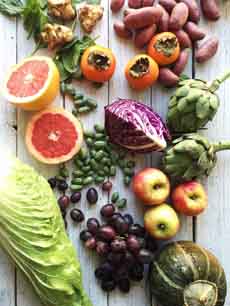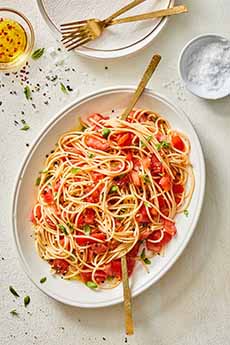|
With so many people going hungry in the U.S. (much less, worldwide), it’s shocking how much food we waste.
It’s not just us, the consumers. It’s the whole food chain, from “ugly” produce left to rot in the field, to problems with transportation and storage, to foods thrown out by grocers, foodservice, etc.
In fact, mre than a third of all food grown for human consumption in the U.S. is wasted, according to ReFED, a nonprofit that focuses on food waste.
That’s about $408 billion worth of food, grown on 18% of U.S. farmland, with 4 trillion tons of water.
The carbon footprint of U.S. food waste is greater than that of the airline industry!
Globally, wasted food accounts for about 8% of all greenhouse gas emissions [source].
Take a moment to think of the environmental consequences of producing food that no one eats.
April 22nd is Earth Day. We can each play a small part in saving our planet, starting with our kitchens.
CONSUMERS & FOOD WASTE
Some 37% of food waste happens in the home.
Why do we waste so much food? We are personally guilty of all of the following.
We buy too much, because we thinking we’ll eat more of it, because it’s on sale (we reach rather than think).
We buy aspirationally, thinking we’ll make a new recipe (but we don’t).
Perishables and leftovers get lost in the back of the fridge, to be found when it’s too late (we do too much of this).
Instead of responsibly using a perishable, we “don’t feel like eating it,” and allow it to deteriorate.
We decide to eat out instead of cooking the perishables that are waiting for us at home.
Each Earth Day, we vow to do better.
It’s like New Year’s resolutions. The intention is good, but the execution is not.
8 SMALL STEPS TO STOP FOOD WASTE
You not only stop food waste; you stop wasting money on the food you’d throw away.
1. PLAN your purchases. In the old days, our Mom had a kitchen calendar/meal planner, with the dinners noted for each day of the week (roast chicken, salmon croquettes, spaghetti, whatever). She did her weekly shopping with a written list that matched the meals.
Even if you don’t cook for a family like Mom did, you can plan your meals.
2. RESIST over-buying. Train yourself to buy too little rather than too much. You’ll likely find that you can “make do” with what you’ve bought.
One way we’ve been working on this is to shop twice a week instead of once a week, so we don’t feel pressure to buy everything at once.
And when we look at that better-priced bag of 10 avocados or tangerines, we pause to think if we can commit to using them all before they go bad.
3. DON’T toss wilted food. Fruits and vegetables that are softened or wrinkled can still be tossed into soups, smoothies, or baked dishes. We love making baked apples when they go soft. Stale bread becomes French toast, croutons or breadcrumbs.
If you don’t know what to do with a soft eggplant, for example, just search online.
4. DON’T rely on the “best before” dates. Produce, eggs, dairy and other foods can remain good well beyond those dates.
A simple test: The sniff test. Then, the taste test: Dip a finger in and taste a tiny amount. You’re likely to find a perfectly edible food.
5. STORE your products like the grocery stores do. The newest food is at the back of the refrigerator case or the shelf. The older products, that need to be used first, are at the front.
This is a really easy way to store perishables, canned goods and other foods, including those you might not think of. For example, olive oil spoils, and even vinegar will go bad over time.
6. KEEP a list of spoiled foods you’ve thrown out. We keep ours on the fridge. This can help identify certain foods that you should cut back on.
7. FREEZE foods before they spoil. We toss a lot of fresh herbs, and leftovers, into the freezer. Bread, seafood, meats and poultry, even cooked pasta can go into the fridge.
8. STORE food correctly. Here are great pointers on the best way to store fruits and vegetables. Always transfer leftovers from open cans into suitable containers. Do not store them in the open cans.
Also note that some fruits give off ethylene, which makes adjacent foods spoil more quickly. Storing apples, bananas and tomatoes apart from other perishables will help keep all perishables fresher.
MORE FOOD STORAGE TIPS
How To Store Coffee
How To Store Fresh Herbs
How To Store Leftover Turkey
How To Store Lemons, Limes & Other Citrus
How To Store Peanut Butter
|
|

[1] Don’t buy them unless you’ll eat them that week (photos #1 and #2 © Good Eggs).

[2] Remember that ground meat spoils more quickly than whole cuts.

[3] Artisan breads often are stale by the next morning. Stick what you won’t be using in the freezer, the day you buy it (photo © Hewn Bread | Chicago).

[4] Don’t push leftover pasta to the back of the fridge. Keep it in sight and plan when to use it. Maybe fry it! (photo © DeLallo).

[5] Even olive oil goes bad. Store it properly (away from light and heat), and only open two bottles at a time: one for cooking, one for dressing or garnish (photo © Flavor Your Life).
|




